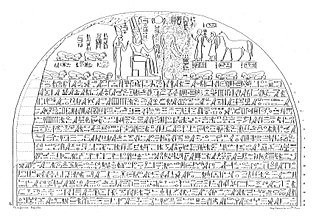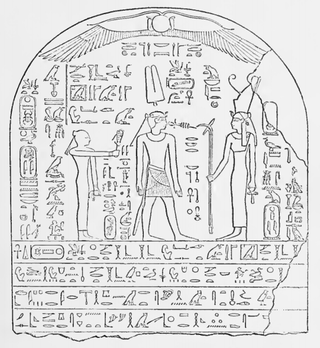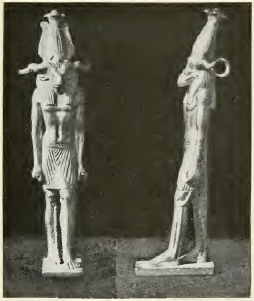
Memphis, or Men-nefer, was the ancient capital of Inebu-hedj, the first nome of Lower Egypt that was known as mḥw ("North"). Its ruins are located in the vicinity of the present-day village of Mit Rahina, in markaz (county) Badrashin, Giza, Egypt. This modern name is probably derived from the late Ancient Egyptian name for Memphis mjt-rhnt meaning "Road of the Ram-Headed Sphinxes".

The Museum of Egyptian Antiquities, commonly known as the Egyptian Museum, located in Cairo, Egypt, houses the largest collection of Egyptian antiquities in the world. It houses over 120,000 items, with a representative amount on display. Located in Tahrir Square in a building built in 1901, it is the largest museum in Africa. Among its masterpieces are Pharaoh Tutankhamun's treasure, including its iconic gold burial mask, widely considered one of the best-known works of art in the world and a prominent symbol of ancient Egypt.

The Sea Peoples are a hypothesized seafaring confederation that attacked ancient Egypt and other regions in the East Mediterranean before and during the Late Bronze Age collapse. Following the creation of the concept in the 19th century, the Sea Peoples' incursions became one of the most famous chapters of Egyptian history, given its connection with, in the words of Wilhelm Max Müller, "the most important questions of ethnography and the primitive history of classic nations".

Piye was an ancient Kushite king and founder of the Twenty-fifth Dynasty of Egypt, who ruled Egypt from 744–714 BC. He ruled from the city of Napata, located deep in Nubia, modern-day Sudan.

François Auguste Ferdinand Mariette was a French scholar, archaeologist and Egyptologist, and the founder of the Egyptian Department of Antiquities, the forerunner of the Supreme Council of Antiquities.

The Stele of Ankh-ef-en-Khonsu is a painted, wooden offering stele located in Cairo, Egypt. It was discovered in 1858 by the French Egyptologist François Auguste Ferdinand Mariette at the mortuary temple of the 18th Dynasty Pharaoh Hatshepsut, located at Deir el-Bahari. It was originally made for the Montu-priest Ankh-ef-en-Khonsu i, and was discovered near his coffin ensemble of two sarcophagi and two anthropomorphic inner coffins. It dates to circa 680–70 BCE, the period of the late 25th Dynasty/early 26th Dynasty. Originally located in the former Boulaq Museum under inventory number 666, the stele was moved around 1902 to the newly opened Egyptian Museum of Cairo, where it remains today.

Menkheperre Ini was an Egyptian king reigning at Thebes during the 8th century BC following the last king of the 23rd Dynasty, Rudamun.
The Saqqara Tablet, now in the Egyptian Museum, is an ancient stone engraving surviving from the Ramesside Period of Egypt which features a list of pharaohs. It was found in 1861 in Saqqara, in the tomb of Tjuneroy, an official of the pharaoh Ramesses II.
Sabu called Kem was High Priest of Ptah, probably during the reign of Pepi I. His precise titles include greatest of the directors of craftsmen belonging to the day of the festival of the Sun, priest of Sokar in the two houses and priest of Ptah.

The Twenty-fifth Dynasty of Egypt, also known as the Nubian Dynasty, the Kushite Empire, the Black Pharaohs, or the Napatans, after their capital Napata, was the last dynasty of the Third Intermediate Period of Egypt that occurred after the Nubian invasion.

Akhethetep was a high dignitary of ancient Egypt who lived during the Fifth Dynasty around 2400 BC. Akhethotep and his son Ptahhotep Tjefi were senior court officials during the rule of Djedkare and of Unas (Wenis), towards the end of the 5th Dynasty. Akhethetep's titles included that of a vizier, making him to the highest official at the royal court, only second to the king. He was also overseer of the treasuries, overseer of the scribes of the king's documents and overseer of the granaries. Akhethetep was the son of Ptahhotep. His father was vizier too.

Sobekemsaf(sbk-m-z3=f) was an ancient Egyptian queen of the 17th Dynasty. She was the wife of pharaoh Nubkheperre Intef and sister of an unidentified pharaoh, probably Sekhemre-Heruhirmaat Intef, Sobekemsaf II or Senakhtenre Ahmose.

Peftjauawybast or Peftjaubast was an ancient Egyptian ruler ("king") of Herakleopolis Magna during the 25th Dynasty.
Kaemtjenent was an ancient Egyptian official under pharaoh Djedkare Isesi in the late Fifth Dynasty, during the Old Kingdom period.
Ptahhotep Desher was an Ancient Egyptian official at the end of the Fifth Dynasty, most likely in office under kings Menkauhor Kaiu and Djedkare Isesi. His main function was that of a vizier. This was the most important office in Ancient Egypt, second only to the king. Ptahhotep also held other titles, such as overseer of the six great houses, overseer of the scribes of the royal documents and overseer of all royal works. These are all important functions, often held by a vizier.

Pehenuikai was an Ancient Egyptian official of the Fifth Dynasty. His main office was that of a vizier, making him to the most important man at the royal court, only second to the king. Beside being vizier, he was also holding many other important titles, such as Overseer of the treasuries, overseer of the scribes of the king's document, overseer of the double granary and overseer of all royal works of the king.
Kay was an Ancient Egyptian official living most likely in the Fifth Dynasty. He is mainly known from his mastaba in Saqqara North. Kay held a high number of important titles making him the most powerful person of his time, only second to the king. His main office was that of a vizier. Besides being vizier, he also held many other important titles, such as Overseer of the treasuries, Overseer of Upper Egypt, overseer of the scribes of the king's document, overseer of the six big houses and overseer of all royal works of the king. His mastaba in Saqqara was recorded by Gaston Maspero who assigned to it the number D 19. Kay bore 51 titles, making him the vizier with the highest number of titles. Kay was the first Egyptian official with the title overseer of the six big houses. The office became one of the most important at the royal court in the later Fifth Dynasty and continued to be so during the subsequent Sixth Dynasty . The dating of Kay is uncertain. No biography is preserved in his tomb, no king's name is mentioned. A date in the middle of the Fifth Dynasty has been proposed. Others prefer a date in the early Fifth Dynasty.
Washptah, with the second name Izi, was an ancient Egyptian official in the Fifth Dynasty under king Neferirkare Kakai. His most important title was that of a vizier, making him to the most important official at the royal court, only second to the king. Next to the office of the vizier he hold several other important positions, including overseer of the scribes of the king's document and overseer of all royal works.
Ptahhotep was an ancient Egyptian official of the Fifth Dynasty, most likely under king Djedkare Isesi. His most important office was that of a vizier, making him to the most important official at the royal court, only second to the king. Next to this important office he held further important titles, such as overseer of the treasuries, overseer of the scribes of the king's document, overseer of the six big houses and overseer of all royal works of the king.
Akhethetep was an ancient Egyptian official mainly known from his mastaba found at Saqqara. Not much is known about Akhethetep. On the reliefs of his mastaba he bears several titles, including overseer of the great house. This was an administrative title of rather unclear function. He had also several religious titles, including priest of Maat and priest of Hathor, lady of Dendera. He had also priestly functions at the funerary cult of different kings and was Priest of Nefer-Djedkare (this is the name of the pyramid of king Djedkare and priest at Nefersut-Unas.














